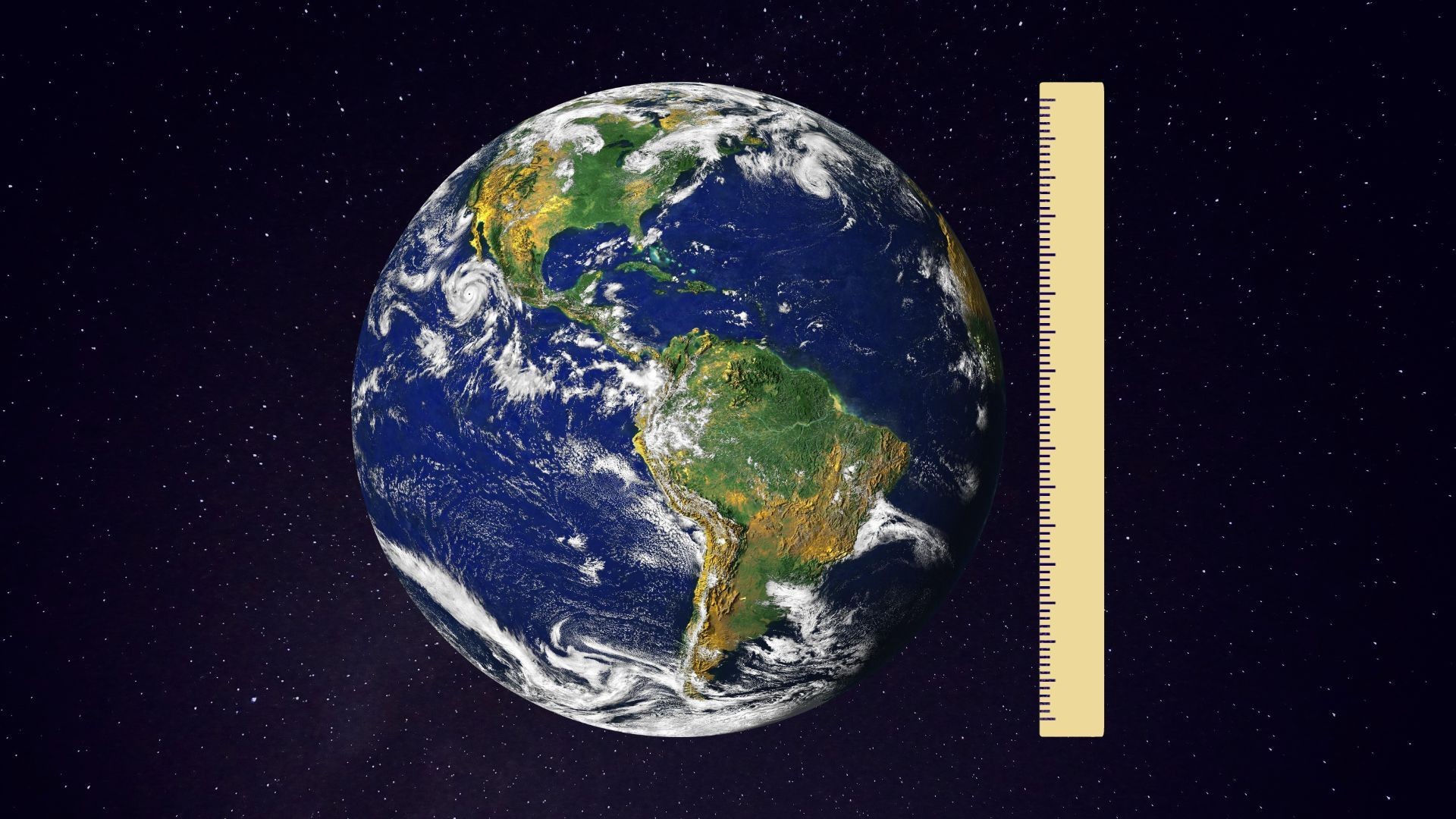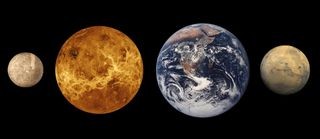What Size Is Earth Compared To Other Planets? Earth, our home, is uniquely positioned in the vast expanse of the solar system, and understanding its size relative to other planets offers a fascinating perspective. At COMPARE.EDU.VN, we delve into the specifics of Earth’s dimensions and contrast them with those of other celestial bodies, offering valuable insights into planetary sizes and the Earth’s place in the universe. Explore the planetary comparison and discover how Earth’s volume, mass, and surface area stack up.
1. Understanding Earth’s Dimensions
Before comparing Earth to other planets, it’s crucial to understand its dimensions. Earth is the fifth-largest planet in our solar system.
- Equatorial Radius: 3,963 miles (6,378 kilometers)
- Polar Radius: 3,950 miles (6,356 kilometers)
- Diameter: 7,926 miles (12,756 km)
- Equatorial Circumference: 24,901 miles (40,075 km)
These measurements reveal that Earth isn’t a perfect sphere; it’s an oblate spheroid, bulging at the equator.
2. Historical Measurements of Earth
2.1. Early Attempts by Philosophers
The quest to measure Earth began in ancient times. Greek philosopher Aristotle made one of the earliest attempts to calculate Earth’s circumference, estimating it to be around 45,500 miles (73,225 km), according to NOAA. While not entirely accurate, it was a significant endeavor for its time.
2.2. Eratosthenes’ Accurate Calculation
Around 250 B.C., Greek polymath Eratosthenes developed a more accurate method using trigonometry. By measuring the position of the sun in Aswan and Alexandria, he calculated Earth’s circumference with approximately 1% accuracy. This method laid the foundation for geodesy, the science of measuring Earth’s size and properties.
3. Modern Methods of Measuring Earth
3.1. Geodesy and Satellite Measurements
Today, scientists use advanced techniques in geodesy, including satellite measurements, to precisely determine Earth’s size and shape. Satellites provide comprehensive data, allowing for accurate calculations of Earth’s radius, diameter, and circumference.
3.2. Understanding Earth’s Shape
Earth’s shape is described as an oblate spheroid due to its bulge at the equator and flattening at the poles. This shape is a result of the centrifugal force caused by Earth’s rotation, which is faster at the equator than at the poles. The equatorial bulge also affects gravity, making it slightly weaker at the equator.
4. Earth’s Volume, Mass, Density, and Surface Area
4.1. Volume and Mass
According to NASA, Earth’s volume is approximately 260 billion cubic miles (1.086 trillion cubic kilometers), and its mass is about 6.6 x 10^21 tons (6 x 10^21 metric tons).
4.2. Density
With the known values of volume and mass, scientists can calculate Earth’s density, which is approximately 5.5 grams per cubic centimeter. This high density is due to Earth’s composition, particularly its iron-rich core.
4.3. Surface Area
The surface area of Earth is approximately 197 million square miles (510 million square kilometers). About 29% (57 million square miles) is land, and 71% (140 million square miles) is water, according to Universetoday.
4.4. Extreme Altitudes
The highest point on Earth’s surface is Mount Everest, peaking at 29,029 feet (8,848 meters) above sea level. However, the point farthest from Earth’s center is the summit of Mount Chimborazo, which is over 6,800 feet (2,073 meters) farther from Earth’s center than Mount Everest’s summit, as stated by NOAA.
5. Comparing Earth to Other Planets in the Solar System
5.1. Earth vs. Gas Giants
When compared to the gas giants—Jupiter, Saturn, Uranus, and Neptune—Earth is significantly smaller.
5.1.1. Earth vs. Jupiter
Jupiter, the largest planet in our solar system, has a diameter of 86,881 miles (139,822 km), making it 11 times wider than Earth, according to NASA. Its volume is approximately 343 trillion cubic miles (1,431 trillion cubic kilometers), meaning it would take about 1,320 Earths to fill Jupiter’s volume. The Great Red Spot, a storm on Jupiter, is wider than Earth.
5.1.2. Earth vs. Saturn
Saturn has a diameter of about 72,367 miles (116,460 km), making it about nine times wider than Earth. It would take approximately 764 Earths to fill Saturn’s volume.
5.1.3. Earth vs. Uranus
Uranus has a diameter of about 31,518 miles (50,724 km), making it about four times wider than Earth. About 63 Earths could fit inside Uranus.
5.1.4. Earth vs. Neptune
Neptune has a diameter of 30,599 miles (49,244 km), approximately four times the width of Earth, according to NASA. It would take about 57 Earths to fill the volume of Neptune.
5.2. Earth vs. Rocky Planets
Earth is the largest of the inner, rocky planets, surpassing Venus, Mars, and Mercury.
5.2.1. Earth vs. Venus
Venus has a diameter of about 7,521 miles (12,104 km), making it slightly smaller than Earth. Venus is often referred to as Earth’s “sister planet” because of their similar size and composition.
5.2.2. Earth vs. Mars
Mars has a diameter of about 4,212 miles (6,779 km), about half the size of Earth. Its smaller size contributes to its lower mass and density.
5.2.3. Earth vs. Mercury
Mercury has a diameter of about 3,032 miles (4,879 km), approximately one-third the size of Earth, according to NASA. Mercury and Earth are the densest planets in the solar system, with similar densities to the iron-rich mineral hematite, according to The Open University.
6. Comparative Tables: Earth vs. Other Planets
To provide a clearer comparison, here are tables summarizing the key dimensions of Earth compared to other planets in our solar system.
6.1. Diameter Comparison
| Planet | Diameter (miles) | Diameter (km) |
|---|---|---|
| Jupiter | 86,881 | 139,822 |
| Saturn | 72,367 | 116,460 |
| Uranus | 31,518 | 50,724 |
| Neptune | 30,599 | 49,244 |
| Earth | 7,926 | 12,756 |
| Venus | 7,521 | 12,104 |
| Mars | 4,212 | 6,779 |
| Mercury | 3,032 | 4,879 |


6.2. Volume Comparison (Relative to Earth)
| Planet | Volume (Earths) |
|---|---|
| Jupiter | 1,320 |
| Saturn | 764 |
| Uranus | 63 |
| Neptune | 57 |
| Venus | 0.86 |
| Mars | 0.15 |
| Mercury | 0.056 |
6.3. Mass Comparison (Relative to Earth)
| Planet | Mass (Earths) |
|---|---|
| Jupiter | 318 |
| Saturn | 95 |
| Uranus | 14.5 |
| Neptune | 17 |
| Venus | 0.815 |
| Mars | 0.107 |
| Mercury | 0.055 |
7. Expert Insights on Earth’s Size
Simon Lock, a research fellow in the School of Earth Sciences at the University of Bristol, offers additional insights into Earth’s size and its comparison with other planets.
7.1. Earth’s Radius
From the very center of the Earth to the surface (Earth’s radius) is 6,378 km (3,963 miles), roughly the distance from Kampala (Uganda) to Kolkata (India) or London to Chicago.
7.2. Earth Compared to Other Planets
Earth is the largest of the rocky, terrestrial planets in our solar system. Mercury, the smallest, is only 40% of Earth’s radius. Jupiter, however, is 11 times bigger than Earth and is the largest planet in our solar system.
7.3. Earth-Like Planets Outside the Solar System
The prevalence of Earth-like planets in other solar systems is hard to determine. While planets with similar mass and composition may be relatively common, many are too close to their stars to host liquid water oceans. Additionally, factors like magnetic fields and moons, which are crucial for stability and protection, are not always present.
8. Why Earth’s Size Matters
8.1. Habitability
Earth’s size is crucial for its habitability. Its mass allows it to retain an atmosphere, and its distance from the sun supports liquid water on its surface.
8.2. Geological Activity
The size of a planet influences its geological activity. Earth’s relatively large size allows for a dynamic core, leading to a magnetic field that protects the planet from harmful solar radiation.
8.3. Comparative Planetology
Understanding Earth’s size in relation to other planets helps scientists study and compare planetary formation, evolution, and potential habitability.
9. FAQs About Earth’s Size
9.1. Who First Determined Earth’s Size?
Aristotle made one of the earliest attempts to estimate Earth’s circumference, while Eratosthenes provided a more accurate calculation using trigonometry around 250 B.C.
9.2. How Do Scientists Measure Earth Today?
Scientists use advanced techniques in geodesy, including satellite measurements, to precisely determine Earth’s size and shape.
9.3. Why Is Earth Bigger at the Equator?
Earth bulges at the equator due to the centrifugal force caused by its rotation. The rotational speed is faster at the equator than at the poles.
9.4. What Is Earth’s Volume?
Earth’s volume is approximately 260 billion cubic miles (1.086 trillion cubic kilometers).
9.5. What Is Earth’s Density?
Earth’s density is approximately 5.5 grams per cubic centimeter.
9.6. How Does Earth Compare to Jupiter in Size?
Jupiter is about 11 times wider than Earth, and about 1,320 Earths could fit inside Jupiter.
9.7. How Does Earth Compare to Mars in Size?
Mars is about half the size of Earth.
9.8. Is Earth the Largest Rocky Planet?
Yes, Earth is the largest of the inner, rocky planets in our solar system.
9.9. What Is the Highest Point on Earth’s Surface?
The highest point is Mount Everest, at 29,029 feet (8,848 meters) above sea level.
9.10. What Is the Farthest Point From Earth’s Center?
The summit of Mount Chimborazo is the farthest point from Earth’s center.
10. Additional Resources for Further Exploration
10.1. Khan Academy
Explore the formation of Earth with Khan Academy’s explanation.
10.2. NASA Exoplanets
Discover conditions across brown dwarfs with a NASA simulation.
10.3. NASA Simulation of Black Holes
Compare the sizes of black holes with distances in the solar system using a NASA simulation.
11. Conclusion: Earth’s Unique Place in the Solar System
Earth’s size, relative to other planets, is a fundamental aspect of its unique properties and habitability. Being the largest of the rocky planets and strategically positioned within the solar system, Earth provides an environment conducive to life. Understanding these comparisons enriches our appreciation for the place we call home.
Navigating the vastness of space and comparing planetary sizes can be daunting. But with COMPARE.EDU.VN, you gain access to detailed, objective comparisons that help you make informed decisions and broaden your understanding. Whether you’re a student, a researcher, or simply curious, COMPARE.EDU.VN is your go-to resource for comprehensive comparisons.
Ready to Explore More?
Do you want to delve deeper into planetary science or compare other fascinating aspects of our universe? Visit COMPARE.EDU.VN today! Our extensive database and expert analysis make comparing complex topics easy and accessible.
Address: 333 Comparison Plaza, Choice City, CA 90210, United States
WhatsApp: +1 (626) 555-9090
Website: COMPARE.EDU.VN
Take the next step in your quest for knowledge and discover the power of comparison with compare.edu.vn!